Thickeners are used in many places in our every day cooking life–gravies, puddings, sauces, pie fillings.
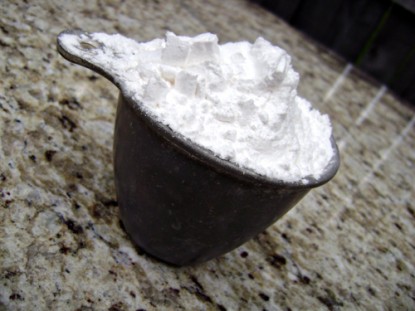
The most common type of thickener is a starch of some kind–it swells up in the liquid. They’re very popular because they don’t add much flavor and add no fat. They all pretty much look alike–a white powder–but they’re not all created equal. They all have different tendencies, but many can be substituted for another in a pinch.
To avoid lumps, mix the starch with an equal amount of cold liquid until it forms a paste, then whisk it into the hot liquid you’re trying to thicken. Once the thickener is added, cook it briefly to remove the starchy flavor. Don’t overcook–liquids thickened with some starches will thin again if cooked too long or at too high a temperature.
- Cornstarch
- Arrowroot
- Tapioca
- ClearJel
- Instant ClearJel
- Flour
 Gives your sauce or gravy a low-gloss, cloudy affect. It’s the best choice for thickening dairy foods, but loses it’s potency with acidic foods and should be avoided. It also doesn’t work well when frozen, it turns spongy. Cornstarch and prolonged heat don’t go along well together, either–it starts to break back down.
Gives your sauce or gravy a low-gloss, cloudy affect. It’s the best choice for thickening dairy foods, but loses it’s potency with acidic foods and should be avoided. It also doesn’t work well when frozen, it turns spongy. Cornstarch and prolonged heat don’t go along well together, either–it starts to break back down.
1 tablespoon (mixed with 1 tablespoon cold water) will thicken 1 cup of hot liquid.
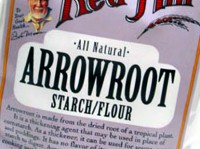 Gives a high-gloss transparent affect to your foods. It has a more neutral flavor over cornstarch or tapioca, so it is a good choice for delicate sauces. It also handles freezing and acidic foods well, but when mixed with dairy, it turns slimy.
Gives a high-gloss transparent affect to your foods. It has a more neutral flavor over cornstarch or tapioca, so it is a good choice for delicate sauces. It also handles freezing and acidic foods well, but when mixed with dairy, it turns slimy.
1 tablespoon (mixed with 1 tablespoon cold water) will thicken 1 cup of hot liquid. Mix arrowroot and cold water together, then whisk into hot liquid for 30 seconds.
 Gives food a high-gloss transparent affect. It thickens food quickly and at a low temperature–it’s great if you need to “fix” your sauce just before serving.
Gives food a high-gloss transparent affect. It thickens food quickly and at a low temperature–it’s great if you need to “fix” your sauce just before serving.
Instant or quick-cooking tapioca grains don’t dissolve completely when cooked, so you end up with tiny gelatinous balls in your food. If that isn’t something that appeals to you for thickening, just whir the tapioca in a spice grinder or blender.
Regular tapioca has small beads and is used to make tapioca pudding.
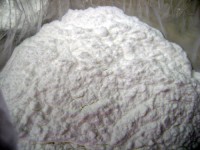 Is a modified cornstarch that works well with acidic ingredients, tolerates high temperatures, doesn’t cause thickened foods to “weep” during storage, and doesn’t begin thickening until the liquid begins to cool allowing heat to penetrate all the way through without breaking down.
Is a modified cornstarch that works well with acidic ingredients, tolerates high temperatures, doesn’t cause thickened foods to “weep” during storage, and doesn’t begin thickening until the liquid begins to cool allowing heat to penetrate all the way through without breaking down.
Because of all of these advantages, it is the only thickener approved by the USDA for home-canning. It makes a beautiful canned pie filling. It can also be used in place of pectin and some of the sugar (or all) when making jams. (It’s also cheaper than pectin or sugar!) The refrigerator life isn’t as long as with pectin and sugar, so a smaller jar is usually used.
It does not handle freezing well at all. It can be used for thickening your everyday sauces and gravies, but it is a little bit more expensive than cornstarch or arrowroot.
It can be ordered online (the best price I’ve found is Barry Farms) or found in Amish/Mennonite stores, but it isn’t available yet in grocery stores.
1 tablespoon (mixed with 1 tablespoon cold water) thickens 1 cup of liquid.
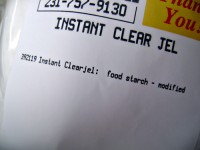 Is a modified cornstarch that is cold-swelling, meaning it thickens instantly without heat and doubly thickens when heated.
Is a modified cornstarch that is cold-swelling, meaning it thickens instantly without heat and doubly thickens when heated.
It handles acidic food well, stands up well to the freezer and to heat (to some degree). It’s especially good for thickening foods without cooking–puddings, juices, dairy, desserts, dressing, syrups, sauces, freezer jams, pre-frozen pies that are later baked.
It is not the same thing as regular ClearJel, don’t use it for canning–the make up of it allows it to thicken only the one time, not for an extended processing time, it will break down.
To avoid clumping, mix with other dry ingredients then add to the liquid. Use a blender, stick blender, food processor, or mixer to blend it all together.
It can be ordered online (the best price I’ve found is Barry Farms) or found in Amish/Mennonite stores, but it isn’t available yet in grocery stores.
1 tablespoon thickens 1 cup of liquid.
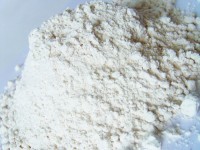 Is one of the starches used to thicken gravies that usually contains fat as a Roux or Beurre Manié, both use the same amount of fat and flour, but just done differently.
Is one of the starches used to thicken gravies that usually contains fat as a Roux or Beurre Manié, both use the same amount of fat and flour, but just done differently.
Roux–ratio is 1 tablespoon fat : 1 tablespoon flour : 1 cup liquid. Melt the fat, stir in the flour and brown until your desired color. Remove from heat and whisk in liquid; return to heat and bring to a boil; cover and simmer for a couple minutes.
Beurre Manié–use same amounts of butter and flour. Soften the butter so it can be mixed into the flour. Drop by nuggets into the liquid and bring to a boil. It will thicken as the flour melts and blends in.
Flour is also used for thickening fresh pies going into the oven.
Mom always used a heavily shaken flour/water mixture (like the cornstarch method, not the roux method) and whisked it into boiling broth to make her gravy. It always worked great for her. I can not make it taste good…it tastes like flour, no matter how much I cook it.
I use cornstarch for most of my every day thickening jobs, ClearJel for canning, and Instant ClearJel for making instant pudding and fat-free desserts.
What thickeners are in your pantry?




joeyfulnoise says:
Thank you for the explanation – being gluten intolerant, we need to use something other than wheat flour – I just never know whether it is best to use arrowroot or corn starch. I’ll get some clear jel instant to have on hand too.
On July 10, 2011 at 7:55 am
Robin from Rurification says:
Thanks for this post! The only place I’ve ever heard of Clear Jel is on this site and I just found an Amish store near us that has it. It was on my list to try some time and now I feel ready to tackle it. I can’t wait to get both kinds. Thank you!
On July 10, 2011 at 8:30 am
GrannyTrace says:
I have cornstarch. I just love all your great info you share with us. Flour never works well with gravy for me.
Have great day.
Granny Trace
http://www.grannytracescrapsandsquares.com
On July 10, 2011 at 9:04 am
lisabetholson says:
Cornstarch and flour, I’m simple like my cooking.
On July 10, 2011 at 9:41 am
Miss Nellie says:
I use all of these but arrowroot I have never used it and haven’t really seen the need in my cooking for that one. I do use flour to make a roux and brown it for gravy and not brown it to make white sauce. Using clear jel makes for great pies and puddings. Thanks for this article with great information.
On July 10, 2011 at 9:46 am
katpecosa1 says:
I use corn starch and flour. However, my mother told me that her family used to keep the water after draining potato’s in a jar in the fridge because it could be used as a thickener. I also believe you can use pasta water as a sauce thickener as well.
I am not sure other than sauces what the starch water could be used for, or how long they keep.
On July 10, 2011 at 10:03 am
CindyP says:
I’d forgotten about potato water….I’d read it somewhere and DID make gravy with it 1 time. It was good! Just that one time, I always forget and drain the potato water down the drain.
On July 10, 2011 at 12:19 pm
TeaCup says:
You can “mash” a few potatoes and do the same thing. This is what I do when I make stew or make gravy from roasted veggies/chicken, and I have cooked potatoes. Mash one or more down, use a stick blender if need be, add pan juices to thin then add back into the proposed gravy/sauce. If you have lumps? They’re not lumps, just really SMALL pieces of potato!
Judi
On July 10, 2011 at 8:25 pm
bonita says:
I just ran across a thai recipe which suggested peanut butter as a thickener!
On July 18, 2011 at 4:58 am
lavenderblue says:
Cindy, when you say cornstarch doesn’t freeze well, do you mean foods thickened with cornstarch or the cornstarch itself, ’cause I may have made a boo-boo. In an effort to get a jump on those horrible little moths that I got last year, I took all grain and bean based foods out of my little wooden cupboard and froze, unfroze, froze again. This included all pasta, cake mixes, cocoa, I even froze my sugar and powdered sugar. And my box of cornstarch.
Will it still be usable? I haven’t made anything that called for it since freezing. Maybe a batch of stir-fry tonight. That way, if the cornstarch doesn’t work, I’ll try Bonita’s peanut butter method. LOL.
On July 18, 2011 at 12:12 pm
CindyP says:
It’s just the food thickened with cornstarch that won’t freeze good. I don’t think freezing the cornstarch to get rid of those pesky little moths will hurt it!
On July 18, 2011 at 8:36 pm
lisabetholson says:
Bonita, will you give the recipe for the Thai food? Thank you.
On July 19, 2011 at 9:41 am
Joy says:
You can’t really call yourself a southern cook unless you can successfully make a roux. I learned when I was about 12 but we didn’t call it a roux—it was just “making a gravy” or “making cream gravy.” I was surprised when I grew up and discovered that I could make a cream sauce or a cheese sauce without measuring anything. And Julie Child’s cream soups were a snap. I made the mistake of making cream of mushroom soup from scratch for Thanksgiving one year when I forgot and bought double the amount of mushrooms. Now I’m stuck making it every year or folks will pout.
On July 19, 2011 at 10:47 am